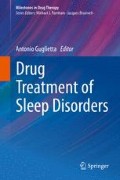Abstract
The role of the melatonin in relation with circadian rhythms and the sleep/wake cycle is well established. It is thought to play a role in controlling the sleep–wake cycle through physiological processes regulated in the suprachiasmatic nucleus of the hypothalamus. In normal subjects, the endogenous circadian period is a little over 24 h, but is entrained to the 24-h day through exposure to light. In the absence of light or light perception (totally blind), the synchronization is lost and the circadian rhythm follows the intrinsic non-24 h clock, resulting in a non-24 h sleep–wake disorder. Non-24 h sleep–wake disorder is characterized by a misalignment of the 24-h light/dark (LD) cycle and a non-entrained sleep/wake cycle propensity resulting in asymptomatic periods alternating with episodes of insomnia, excessive daytime sleepiness (EDS), or a combination of both. Tasimelteon (VEC-162) is an orally bioavailable melatonin receptor agonist of the melatonin MT1 and MT2 receptors recently approved by the U.S. Food and Drug Administration (FDA) for the treatment of non-24 h sleep–wake rhythm disorder.
Access this chapter
Tax calculation will be finalised at checkout
Purchases are for personal use only
References
AASM (2014) International classification of sleep disorders, 3rd edn
American Academy of Sleep Medicine (2014) International classification of sleep disorders, 3rd edn. American Academy of Sleep Medicine, Darien, IL
Buscemi N, Vandermeer B, Hooton N, Pandya R, Tjosvold L, Hartling L, Baker G, Klassen TP, Vohra S (2005) The efficacy and safety of exogenous melatonin for primary sleep disorders. A meta-analysis. J Gen Intern Med 20(12):1151–1158. doi:10.1111/j.1525-1497.2005.0243.x
Cardinali DP, Pandi-Perumal SR, Niles LP, Brown GM (2010) Melatonin and sleep: possible involvement of GABAergic mechanisms. In: Monti JM, Pandi-Perumal SR, Mohler H (eds) GABA and sleep. Springer, Switzerland
Dhillon S, Clarke M (2014) Tasimelteon: first global approval. Drugs 74(4):505–511. doi:10.1007/s40265-014-0200-1
Dressman MA, Licamele L, Feeney J, Polymeropoulos MH (2012) Seventy percent of totally blind people with sleep complaints are not entrained to the 24 hour clock. Vanda Pharmaceuticals Inc., Washington, DC
Hardeland R, Pandi-Perumal SR, Cardinali DP (2006) Melatonin. Int J Biochem Cell Biol 38(3):313–316. doi:10.1016/j.biocel.2005.08.020
Keijzer H, Smits MG, Duffy JF, Curfs LM (2013) Why the dim light melatonin onset (DLMO) should be measured before treatment of patients with circadian rhythm sleep disorders. Sleep Med Rev 18(4):333–339. doi:10.1016/j.smrv.2013.12.001
Lankford DA (2011) Tasimelteon for insomnia. Expert Opin Investig Drugs 20(7):987–993. doi:10.1517/13543784.2011.583235
Lewy AJ (2003) Clinical applications of melatonin in circadian disorders. Dialogues Clin Neurosci 5(4):399–413
Lewy AJ, Emens J, Sack RL, Hasler BP, Bernert RA (2003) Zeitgeber hierarchy in humans: resetting the circadian phase positions of blind people using melatonin. Chronobiol Int 20(5):837–852
Lockley SW, Skene DJ, James K, Thapan K, Wright J, Arendt J (2000) Melatonin administration can entrain the free-running circadian system of blind subjects. J Endocrinol 164(1):R1–R6
Lockley SW, Dressman MA, Xiao C, Fisher DM, Torres R, Lavedan C, Licamele L, Polymeropoulos MH (2013a) Tasimelteon treatment entrains the circadian clock and demonstrates a clinically meaningful benefit in totally blind individuals with non-24-hour circadian rhythms. In: 95th Annual meeting of the endocrine society, Abstract SUN-134
Lockley SW, Dressman MA, Xiao C, Licamele L, Polymeropoulos MH (2013b) RESET study demonstrates that tasimelteon maintains entrainment of melatonin and cortisol in totally blind individuals with non-24-hour circadian rhythms. In: 95th Annual meeting of the endocrine society, Abstract SUN-137
Pandi-Perumal SR, Zisapel N, Srinivasan V, Cardinali DP (2005) Melatonin and sleep in aging population. Exp Gerontol 40(12):911–925. doi:10.1016/j.exger.2005.08.009
Pandi-Perumal SR, Srinivasan V, Maestroni GJ, Cardinali DP, Poeggeler B, Hardeland R (2006) Melatonin: nature’s most versatile biological signal? FEBS J 273(13):2813–2838. doi:10.1111/j.1742-4658.2006.05322.x
Pandi-Perumal SR, Srinivasan V, Spence DW, Cardinali DP (2007) Role of the melatonin system in the control of sleep: therapeutic implications. CNS Drugs 21(12):995–1018
Rajaratnam SM, Polymeropoulos MH, Fisher DM, Roth T, Scott C, Birznieks G, Klerman EB (2009) Melatonin agonist tasimelteon (VEC-162) for transient insomnia after sleep-time shift: two randomised controlled multicentre trials. Lancet 373(9662):482–491
Sack RL, Lewy AJ (2001) Circadian rhythm sleep disorders: lessons from the blind. Sleep Med Rev 5(3):189–206. doi:10.1053/smrv.2000.0147
Smits MG, Pandi-Perumal SR, Warren Spence D, Brown GM (2010) Dim light melatonin onset (DLMO) in psychiatric disorders. In: Pandi-Perumal SR, Kramer MCUP (eds) Sleep and mental illness. Cambridge University Press, Cambridge
VandaPharmaceuticals (2014) Tasimelteon Prescribing Information
Williamson BL, Tomlinson AJ, Mishra PK, Gleich GJ, Naylor S (1998) Structural characterization of contaminants found in commercial preparations of melatonin: similarities to case-related compounds from L-tryptophan associated with eosinophilia-myalgia syndrome. Chem Res Toxicol 11(3):234–240. doi:10.1021/tx970202h
Author information
Authors and Affiliations
Corresponding author
Editor information
Editors and Affiliations
Rights and permissions
Copyright information
© 2015 Springer International Publishing Switzerland
About this chapter
Cite this chapter
Neubauer, D.N., BaHammam, A.S., Pandi-Perumal, S.R. (2015). Tasimelteon. In: Guglietta, A. (eds) Drug Treatment of Sleep Disorders. Milestones in Drug Therapy. Springer, Cham. https://doi.org/10.1007/978-3-319-11514-6_13
Download citation
DOI: https://doi.org/10.1007/978-3-319-11514-6_13
Published:
Publisher Name: Springer, Cham
Print ISBN: 978-3-319-11513-9
Online ISBN: 978-3-319-11514-6
eBook Packages: Biomedical and Life SciencesBiomedical and Life Sciences (R0)

